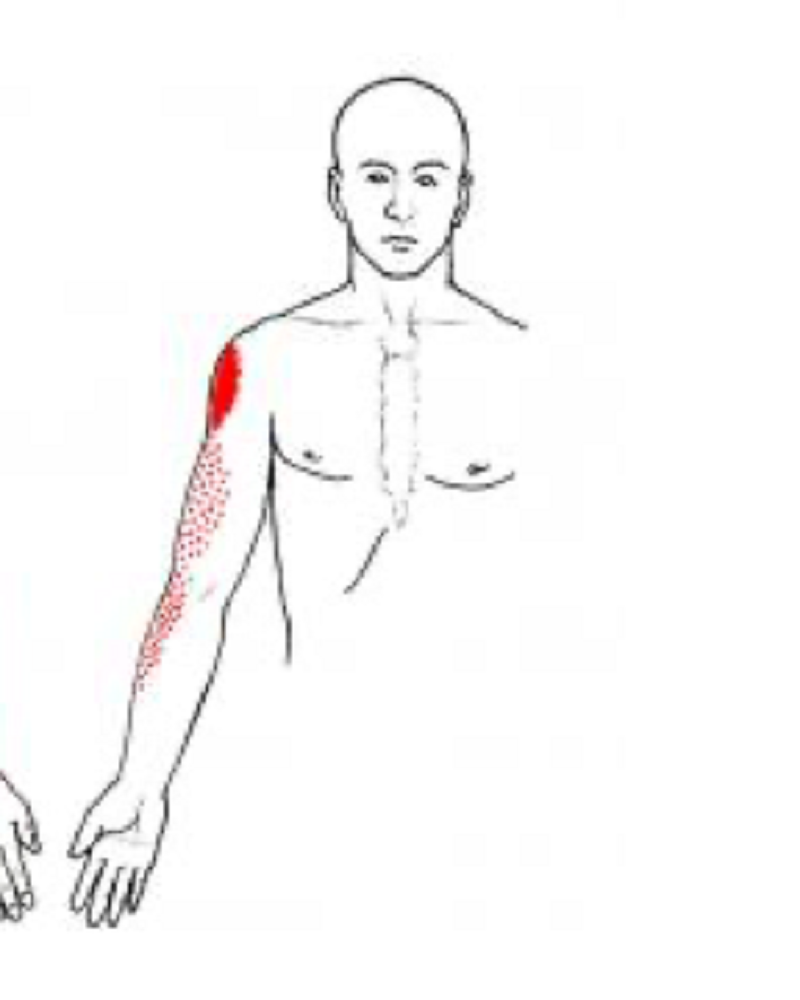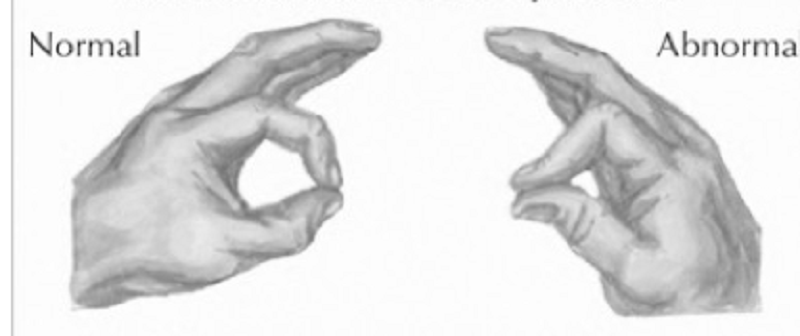Shoulder and Elbow Assessment Quiz

Shoulder and Elbow Assessment Quiz
Test your knowledge on shoulder and elbow assessments with this comprehensive quiz featuring 34 questions that cover anatomy, injuries, and rehabilitation methods. Perfect for physical therapists, students, and healthcare professionals looking to enhance their assessment skills.
- Multiple-choice and checkbox questions
- Focuses on the latest clinical guidelines
- Ideal for evaluations and self-assessment
Your patient presents to PT with pain in the shoulder at 85 degrees. Based on the concept of the "total arc of motion," what are you suspecting is involved?
Acromioclavicular
Glenohumeral
Subacromial space
Rotator cuff
You are evaluating a patient with shoulder pain, and you note scapular dyskinesia upon shoulder elevation. Which of the following would MOST contribute to loss of scapular stabilization?
Weak upper trapezius
Weak/lengthened lower trapezius
Early/excessive protraction
Tight medial rotators
You note a diminished response testing your patient's triceps reflex. What level is affected?
C5, 6
C6
C6, 7
C7, 8
You are performing an apprehension/relocation test on your patient's shoulder. With relocation, their symptoms decrease. What type of test result is this?
Positive
Negative
Inconclusive
Which of the following is NOT a shoulder impingement test?
Drop Arm
Neer
Hawkin's Kennedy
Cross-over
Which of the following is not part of the full thickness RC tear test item cluster?
Drop arm
Painful arc
Speed's
Infraspinatus MMT
Which of the following lists ALL of the contents of the subacromial space correctly?
Supraspinatus tendon and muscle, subacromial bursae, suprascapular nerve, part of superior capsule
Supraspinatus tendon and muscle, subacromial bursae, suprascapular nerve, greater tubercle of humerus
Supraspinatus tendon and muscle, subacromial bursae, suprascapular nerve, greater tubercle of humerus
Supraspinatus tendon and muscle, subacromial bursae, LH of biceps tendon, part of superior capsule
A patient is referred to you from an orthopedic surgeon diagnosed with a RC tendinopathy. Based on what you know, which RC tendon is most susceptible to RC tendinopathy?
Supraspinatus
Infraspinatus
Teres minor
Subscapularis
A 45 year old male presents to PT with shoulder pain. Upon testing, you note that abduction are painful and limited, a painful arc 60-120 degrees, positive Neer's and Hawkin's Kennedy, and pain/weakness with resisted abduction & ER
Bursitis
Posterior glenoid impingement
Rotator cuff tendinopathy
Bicipital tendinitis
A hill-sach's lesion is associated with which of the following?
Inferior dislocation
Anterior dislocation
SLAP tear
Shoulder instability
Check of all the following that are associated with a SLAP tear
Possible biceps tendon avulsion
Locking, popping, catching
Anterior shoulder pain
Posterior shoulder pain
You are evaluating a patient in an outpatient clinic whose imaging states they have a Grade III SLAP tear. What should you expect physiologically?
Detachment of labrum and biceps (sup)
Fraying, but labrum and biceps attached
Bucket handle tear extends to biceps
Vertical tear of superior labrum
You are evaluating a patient who you determine has a frozen shoulder. They ask you how long it should take for their pain to decrease. Based on the stages, what should you tell them?
About 4-6 months
About 3-8 months
About 1-3 months
About 8-12 months
You are treating a 75 year old female patient who has had a gradual onset of shoulder pain over the past few years, which has worsened in the past few months. When she vacuums her house, she gets pain in the posterior aspect of her shoulder. She reports that her pain is worse in the morning, but loosens up throughout the day. When she elevates her arm, she says she feels a "crunching." What is the most likely diagnosis?
Frozen shoulder
Osteoarthritis
Rheumatoid arthritis
Bursitis
You are treating a pediatric patient who has a Salter Harris Type III fracture. What does this mean?
There is a fracture through a portion of the physis that extends through the metaphysis
There is a fracture through a portion of the physis that extends through the epiphysis and into the joint
There is a fracture across the metaphysis, physis, and epiphysis
There is a crush injury to the physis
The primary role of the elbow is:
To position the elbow for writing
To allow for wrist function
To position the shoulder for function
To position the hand for function
The closed packed position of the humeroradial joint is:
0 degrees elbow extension/5 degrees supination
90 degrees elbow flexion/5 degrees supination
150 degrees elbow flexion/5 degrees pronation
90 degrees elbow flexion/5 degrees pronation

This image shows the referral pattern for which muscle?
Supraspinatus
Biceps brachii
Middle deltoid
Pronator teres
When testing the strength of your patient's muscles, they seem to be weaker in pronation than they are in supination. Is this normal?
No, supination strength should be 85% of supination strength
No, supination strength should be 60% of pronation strength
Yes, pronation strength should be 85% of supination strength
Yes, pronation strength should be 60% of supination strength
A moving varus stress test assesses laxity of:
UCL/LCL
RCL/LCL
UCL/RCL
UCL/annular ligament
You are examining a patient and when testing their peripheral sensation, they report diminished sensation at the medial aspect of the anterior forearm. What nerve is likely affected?
Medial cutaneous nerve of the arm
Lower lateral cutaneous nerve of the arm
Anterior medial cutaneous nerve of the arm
Posterior cutaneous nerve of the forearm
A tendinitis will take ______ to heal, whereas a tendinitis or tendinopathy will take _______ to heal
3 weeks/6 weeks
6 weeks/10-12 weeks
3 weeks/6 months
3 weeks/8 months
Which of the following is not a predisposing factor to post-tramautic/immobilization stiffness
Significant joint congruity
Joint traversed by tendon
Intra-articular fractures are difficult to immobilize
Joint capsule has a propensity to thicken and become contracted
The radial nerve passes through which muscle?
Pronator teres
Pronator quadratus
Supinator
ECRL
You are evaluating a patient who reports having difficulty pinching and has begun to have difficulty pronating, but they have full sensation in the forearm. What might be the cause?
Pronator syndrome
Anterior interosseous syndrome
Lateral epicondylitis
Supinator syndrome
The functional position of the hand is:
Slight flexion (20 deg) and UD (10 deg)
Slight flexion (20 deg) and RD (10 deg)
Slight extension (20 deg) and UD (10 deg)
Slight extension (20 deg) and RD (10 deg)
A swan-neck deformity consists of the following:
MCP & DIP flexion, PIP extension
MCP & DIP extension, PIP flexion
MCP & PIP flexion, DIP extension
MCP & PIP extension, DIP flexion

If your patient presents as the right image when asked to perform a tip pinch, which nerve is affected?
Ulnar nerve
Radial nerve
Posterior interosseous
Anterior interosseous
Which of the following are the contents of the 2nd extensor compartment?
ECRB, ECRL
APL, EPB
EPL
ECU
A patient presents with morning stiffness in the fourth finger, and has difficulty gripping objects. They are unable to extend their finger, and you note a palpable nodule on the palmar aspect of the fourth finger. What is the most likely condition?
Tenosynovitis
Scaphoid fracture
MCP joint dislocation
Trigger finger
Which of the following is not a characteristic of Kienbock's disease?
Necrotic changes in scaphoid due to loss of blood supply
Associated with negative ulnar variance
Impaired wrist strength and ROM
Most common in men 20-40 y.o.
A Colle's fracture involves which of the following?
Distal ulna with dorsal displacement of distal fragment and radial shift of carpus and hand
Distal radius with dorsal displacement of distal fragment and radial shift of carpus and hand
Distal ulna with dorsal displacement of distal fragment and ulnar shift of carpus and hand
Distal radius with dorsal displacement of distal fragment and ulnar shift of carpus and hand
A patient presents to PT with a fracture through the proximal pole of the scaphoid. Their doctor educated them that depending on where the fracture is, the bone may become necrotic d/t lack of blood supply. The doctor did not educate them on the level of incidence based on the location of fracture. They ask you what their chance/incidence of AVN is. What should you tell them?
Low incidence of AVN
Moderate incidence of AVN
High incidence of AVN
Which of the following is not part of the CPR for Carpal Tunnel Syndrome?
Relief from shaking hands
Symptom severity scale >2.9
Age >45
Reduced sensory field of the 1st digit
{"name":"Shoulder and Elbow Assessment Quiz", "url":"https://www.quiz-maker.com/QPREVIEW","txt":"Test your knowledge on shoulder and elbow assessments with this comprehensive quiz featuring 34 questions that cover anatomy, injuries, and rehabilitation methods. Perfect for physical therapists, students, and healthcare professionals looking to enhance their assessment skills.Multiple-choice and checkbox questionsFocuses on the latest clinical guidelinesIdeal for evaluations and self-assessment","img":"https:/images/course1.png"}
More Quizzes
PT Procedures
532618
Diagnosis Matching OTA 220
8418
Olympus F1.2 Pro Lens Series - Quiz (Canada)
1050
Are you Eaglefreek or RomaanFoxx?
1050
Quiz: What Are Physiological or Psychological Deficiencies?
201029682
Think You Know R? Take Our Free Programming Now
201031479
Find Out What Superpower You'd Have - Free
201028716
Free 4.11 Macbeth Review
201024006
Italian Trivia Questions: Test Your Italian Food IQ
201031479
Free General Science & History Knowledge
201029030
Free EMS Systems Ch1 Worksheet Answers
201027540
Challenge Your Mind: Take Our Cognitive Distortions
201026476